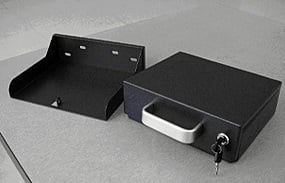Simple Narcotics Tracking / Narcotics Compliance
A guide to the features available for narcotics compliance tracking, including in the case of an audit
AngelTrack has two different systems for documenting and tracking your agency's narcotics. One system is simple, and is discussed below; the other system is complex, providing end-to-end tracking of each individual vial.
Please consult your legal counsel in deciding which narcotics tracking system is appropriate for your agency, against the threat of a DEA audit. The DEA can fine you $2,000.00 for each dose you cannot account for, and restrict or altogether revoke your DEA number.

Configuring Your Medications List
Using the Medications List available from the Settings page, make sure all of your narcotics are in the list and are flagged as such:
- ☑ Narcotic, and
- ☑ Crew must record a dose ID number from the vial
...on all medication types that you must track. When this flag is set, the PCR will prompt crew members to type in the dose identification number from the vial... even if the dose was wasted.
End-to-End Vials Tracking is Also Available
AngelTrack has a simple vial-tracking system built in. Once you make the aforementioned adjustments to your Medications List, AngelTrack's PCR will collect the vial IDs from the crew, along with electronic signatures. Various reports and grids allow you to pull the PCR-Medications records later according to medication, so that you can show all doses given and wasted.
This simple system is discussed below.
If, however, you need end-to-end per-vial tracking, then AngelTrack has that too. Please refer to the Vial Tracking Guide to learn how to activate and use the full system.
Please consult your legal counsel to decide which narcotics-tracking system is appropriate for your agency.
Two Different Approaches to Issuing Narcotics
You company is required to know where all of its narcotics doses are at any given time... and yet you must allow crews to carry narcotics around with them during the day. There are two approaches to solving this problem:
Approach 1: Daily Checkout / Checkin
In the morning, a supervisor issues a narcotics pouch to each crew, inspecting the contents and collecting signatures from the recipients. Each evening, the pouches are returned, with another inspection and signoff.
This is a strong system but requires there to be a supervisor at the station every morning and evening without fail. Therefore it is difficult for smaller EMS operations to implement, because their supervisors spend most of their time aboard an ambulance.
Approach 2: Lockbox Assignment
 When hired, paramedics are issued a small padded lockbox containing two doses of each reportable narcotic, and the key. When off shift, the paramedic stores his lockbox in a locker or locking trays provided for this purpose at the station, in a location that is continuously observed by security camera. At any time, the paramedic must answer for the box's contents.
When hired, paramedics are issued a small padded lockbox containing two doses of each reportable narcotic, and the key. When off shift, the paramedic stores his lockbox in a locker or locking trays provided for this purpose at the station, in a location that is continuously observed by security camera. At any time, the paramedic must answer for the box's contents.
This system dispenses with the daily checkin/checkout, which means it can sustain itself even when no supervisors are present at the station. There will be an occasional hassle when someone loses their key or forgets their combination, but other than that it is a low-maintenance alternative. It does require the company to purchase additional doses, because every paramedic on the payroll must have a full set of narcotics in their name, plus enough spare doses to restock any that are used.
There are lockbox systems available that include locking trays and sleeves, for securely storing the lockboxes on the wall at the station. Additional trays/sleeves can be purchased and installed inside the ambulances, so that the paramedic can securely leave their lockbox in the vehicle during their shift. Just buy an extra sleeve for each vehicle, and bolt it in the back near the stretcher mount.
During a DEA audit, you must account for every single dose, going as far back in time as they see fit. Each unaccounted-for dose carries a fine up to $2000.00. They will also review your tracking procedure, and they might suspend your DEA number if they are not satisfied that your employees are committed to that procedure.
Clear it with your legal team first
This is not legal advice. Narcotics laws vary by state, and the attitudes of DEA auditors vary by region. Submit your proposed tracking system and associated policies to your legal team before putting it in practice.
Crew Responsibilities
Crews are responsible for keeping track of their lockbox or pouch during their shift. At shift end, crews will sign the pouch back in or lock it up, depending on which of the above approaches your company took. In any case, we recommend you do not permit any narcotics to remain on board an ambulance once it is out of service.
Crews are also responsible for creating the appropriate medication records in AngelTrack's PCR whenever narcotics are used or wasted. No matter what happened to that dose, it must be recorded in AngelTrack, period. When a crew signs their narcotics back in, if a dose is missing, the crew should be able to open the PCR and show the medication record they created for the consumption of that dose.
Automatic witness signature form
When the crew indicates that a narcotic was used or wasted, AngelTrack automatically requires a signature on the appropriate "Narcotics Witness Verification" form. That form should be signed by medical personnel at the destination facility, or failing that, by the other crew member.
Supervisor Responsibilities
Supervisors are responsible for developing and administering the system of boxes or pouches that are issued to crews. That means issuing keys to storage lockers or racks, and keeping track of who is assigned which lockbox or locker.
Supervisors also maintain the change-of-hands log, that documents each time a box/pouch changes hands, attesting its contents.
Whenever a dose is used, supervisors are responsible for restocking the dose, and notating the station's narcotics inventory to show that the dose was issued to a particular box/pouch. Before issuing the replacement dose, the supervisor can verify the AngelTrack PCR record showing the disposition of the original dose -- be it administered or be it wasted. The supervisor can either inspect the PCR record on the crew's tablet, or they can use the Medication Usage Report on their own tablet to see the dose record.

During an Audit
Part of any DEA audit is a dose accounting. The auditors will already have a list of all narcotics that your company purchased (your supplier reports all narcotics purchases directly to the DEA). They will ask to see documentation of where each dose was administered or wasted. AngelTrack's Medication Usage Detail report was specifically designed to help you during this audit.
The report allows you to specify any medication and any date range. It will show all doses given and wasted during that date range, by all employees or by a specific employee. It also shows dose/vial identification numbers, if you have elected to record those numbers. DEA auditors usually do not insist on tracking at that level of granularity, but if you show that you can in fact track each numbered vial, all the better.
The report also includes links to the printed run reports of all cases where narcotics were used or wasted. You can download all the report .PDFs and provide them to the auditor.
The Medication Usage Detail Report is accessed by first visiting the Medication Usage Report under Supervisor Home. Click on any medication in that report to dive down to the detail report.
You can also show the auditors the Narcotics Usage Report under HR Home, which looks for patterns of use and waste across all crews. The report is designed to identify crews who use or waste an unusually large amount of narcotics. You can show the report to the auditors in order to demonstrate that your company maintains awareness of its narcotics usage rates, with an eye for patterns indicating diversion.